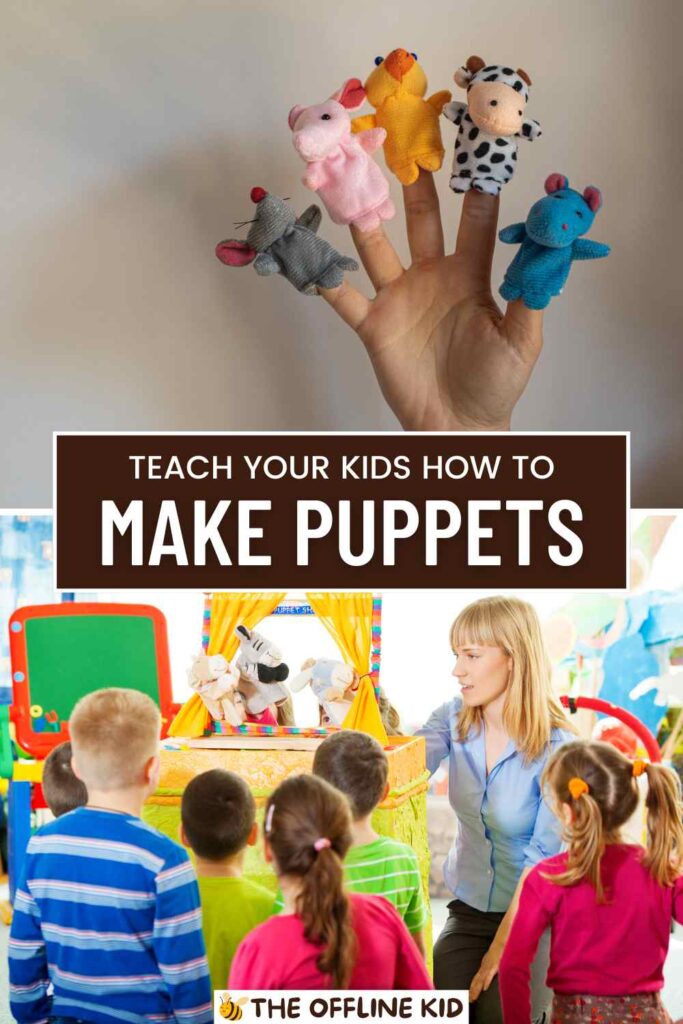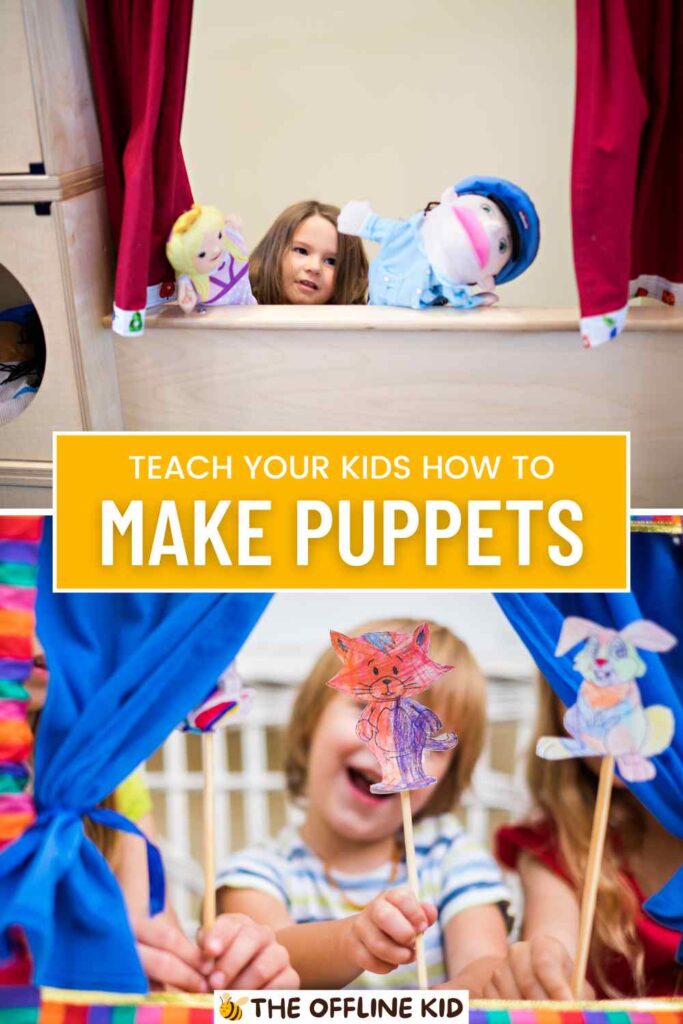Welcome to the wonderful world of puppet making! This guide will help you and your kids create amazing handmade puppets, fostering creativity and fun.
Let’s embark on this imaginative journey together and bring stories to life with your very own puppets!
The Magic of Puppetry
Brief History of Puppets
Puppets have been captivating audiences for centuries, with their origins tracing back to ancient civilizations.
From the shadow puppets of Asia to the marionettes of Europe, these animated figures have told stories, entertained, and educated people of all ages.
Understanding the rich history of puppetry can inspire you and your kids to appreciate this timeless art form even more.
Different Types of Puppets Around the World
- Shadow Puppets: Originating from China and India, these puppets use intricate cutouts and a light source to cast shadows on a screen, creating mesmerizing storytelling experiences.
- Hand Puppets: Commonly used in Europe and North America, these puppets are worn on the hand and controlled by the puppeteer’s fingers.
- Marionettes: Popular in Italy and France, marionettes are string-operated puppets that require skillful manipulation.
- Sock Puppets: These are simple, yet creative puppets made from socks and are loved by children worldwide.
- Finger Puppets: Small and easy to make, finger puppets are perfect for young children and can depict a wide range of characters.
Benefits of Puppet Making and Puppet Play for Kids
Creating and playing with puppets offers numerous developmental benefits for children:
- Enhances Creativity: Crafting puppets encourages kids to use their imagination and creativity in designing characters and stories.
- Improves Fine Motor Skills: Cutting, gluing, and assembling puppets help develop fine motor skills and hand-eye coordination.
- Boosts Communication Skills: Puppet play involves storytelling and dialogue, which can improve language and communication abilities.
- Fosters Emotional Expression: Puppets can serve as a safe medium for children to express their feelings and work through emotions.
- Encourages Teamwork: Group puppet-making projects teach kids to collaborate, share ideas, and work together towards a common goal.
Engaging in the art of puppetry not only provides hours of entertainment but also contributes to the holistic development of children.
By delving into the magic of puppetry, you and your kids will embark on a creative adventure that is both educational and fun.
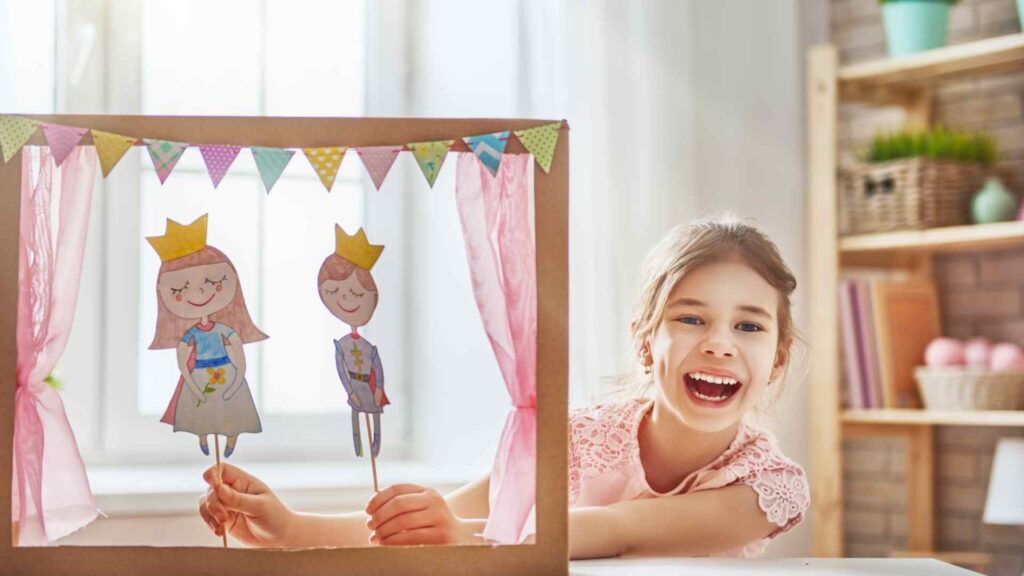
Getting Started
Whether you’re a beginner or a seasoned crafter, setting the stage for puppet-making fun involves gathering the right materials and creating a conducive workspace. Here’s how to get started:
Materials You’ll Need
- Basic Supplies: Scissors, glue (preferably craft glue or hot glue gun), markers or pens, tape, and a ruler.
- Craft Materials: Construction paper, felt, fabric scraps, yarn, buttons, googly eyes, feathers, and any other decorative items you wish to use.
- Optional Tools: Sewing needle and thread (for fabric puppets), craft sticks or wooden dowels (for rod puppets), and a flashlight or lamp (for shadow puppets).
Setting Up Your Puppet-Making Space
- Choose a Well-Lit Area: Natural light or a good desk lamp ensures you can see your materials clearly.
- Cover Surfaces: Lay down newspaper or a plastic tablecloth to protect your workspace from glue and paint spills.
- Organize Materials: Use small containers or trays to keep materials sorted and easily accessible.
- Safety First: Ensure scissors and any sharp tools are used under adult supervision, especially with younger children.
By gathering these materials and setting up a dedicated puppet-making area, you’re ready to embark on a creative journey with your kids. The next step involves planning the types of puppets you want to create and designing their unique personalities.
Planning Your Puppets
Before diving into crafting, take some time to plan and design the puppets you and your kids want to create.
This stage is crucial for sparking creativity and ensuring your puppets turn out just the way you envision them.
Choosing a Puppet Type
- Finger Puppets: Ideal for small hands and simple designs, these puppets are great for storytelling and imaginative play.
- Hand Puppets: Larger and more versatile, hand puppets can be operated with one hand and are perfect for role-playing and puppet shows.
- Sock Puppets: Using old socks as the base, these puppets are easy to make and can be customized with various decorations.
- Shadow Puppets: Create silhouettes using cardboard or thick paper and tell stories using light and shadow.
Designing Your Puppet
- Drawing Templates and Sketches: Sketch out your puppet designs on paper to visualize their shapes, sizes, and features.
- Deciding on Characters and Stories: Think about the personalities your puppets will have and the stories they might tell. Will they be animals, monsters, or humans? What adventures will they embark on?
By planning your puppets ahead of time, you can ensure a smooth crafting process and help your kids engage more deeply in the creative aspect of puppet making. Next, we’ll dive into creating simple finger puppets, a perfect starting point for beginners.
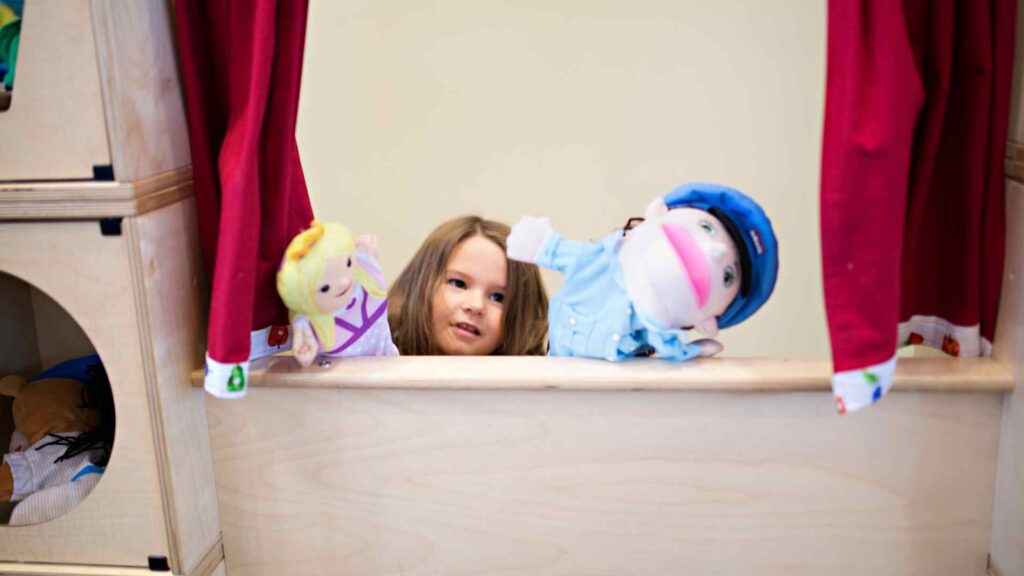
Creating Simple Finger Puppets
Finger puppets are delightful, easy-to-make characters that can bring endless storytelling possibilities to life. Here’s how to create your own:
Step-by-Step Instructions for Basic Finger Puppets
- Materials Needed:
- Colored felt or construction paper
- Scissors
- Glue (craft glue or hot glue gun)
- Markers or pens for decorating
- Googly eyes, yarn, or other embellishments
- Cutting and Assembling:
- Start by cutting out a basic puppet shape from felt or construction paper. The shape can be simple, like a circle or rectangle, depending on your design.
- Fold the felt or paper in half and glue along the edges, leaving the bottom open for your finger.
- Decorate the puppet with markers, adding eyes, a mouth, and any other features you like. You can also glue on yarn for hair or fabric scraps for clothes.
- Adding Details: Faces, Clothes, and Accessories:
- Use small pieces of felt or fabric scraps to create outfits or accessories for your puppets.
- Glue on googly eyes or draw facial features with markers to give your puppet personality.
- Experiment with different colors and textures to make each puppet unique.
- Creative Variations and Ideas:
- Animal Finger Puppets: Create puppets shaped like animals such as cats, dogs, or birds.
- Fantasy Creatures: Design puppets inspired by mythical creatures like dragons or unicorns.
- Storybook Characters: Make finger puppets based on favorite storybook characters or nursery rhymes.
Creating finger puppets is a fantastic way to introduce kids to puppet making. It’s simple, fun, and allows for plenty of creativity in designing characters. Once you’ve mastered finger puppets, you can move on to making larger hand puppets or exploring other puppet types like sock or shadow puppets.
Making Hand Puppets
Hand puppets offer a larger canvas for creativity and storytelling. Here’s how to craft your own hand puppets and bring characters to life:
Introduction to Hand Puppets
Hand puppets are versatile puppets that fit over your hand and are controlled by moving your fingers inside the puppet’s head and arms. They’re perfect for interactive play and puppet shows.
Step-by-Step Guide to Making a Basic Hand Puppet
- Materials Needed:
- Large piece of felt or fabric
- Scissors
- Glue (craft glue or hot glue gun) or sewing materials (needle and thread)
- Markers or pens for decorating
- Googly eyes, yarn, or fabric scraps for embellishments
- Sewing or Gluing Fabric:
- Fold your fabric or felt in half and place your hand on top to measure the size of the puppet’s body. Leave extra fabric at the bottom to create the puppet’s neck.
- Sew or glue the edges together, leaving an opening at the bottom large enough for your hand to fit inside.
- Turn the puppet inside out so the seams are hidden inside.
- Adding Features: Eyes, Mouth, Hair:
- Decorate your puppet’s face using markers, googly eyes, or sewn-on felt pieces for eyes and a mouth.
- Glue or sew yarn or fabric scraps onto the puppet’s head for hair or other details.
- Create additional features like ears, noses, or hats using extra fabric or felt.
- Customizing Your Hand Puppets:
- Personalize your puppets by giving them unique personalities and characteristics.
- Use different colors and textures of fabric to create costumes or outfits for your puppets.
- Encourage kids to brainstorm and design their own puppet characters based on their favorite stories or imagination.
Crafting hand puppets is a rewarding activity that enhances storytelling skills and encourages imaginative play. Once your puppets are complete, practice puppet manipulation techniques to bring your characters to life and create your own puppet shows at home.
Crafting Sock Puppets
Sock puppets are a classic favorite among kids and adults alike. They are easy to make and can be personalized in countless creative ways. Here’s how to craft your own sock puppets:
The Charm of Sock Puppets
Sock puppets are made from ordinary socks, transforming them into lively characters through simple crafting techniques. They’re perfect for storytelling, role-playing, and puppet shows.
How to Make a Basic Sock Puppet
- Materials Needed:
- Clean sock (old socks work well)
- Scissors
- Glue (craft glue or hot glue gun)
- Markers or pens for decorating
- Googly eyes, yarn, fabric scraps, buttons, or other decorative items
- Decorating the Sock:
- Place the sock on your hand and decide where you want the puppet’s features to go, such as eyes, nose, and mouth.
- Use markers or fabric paint to draw facial features directly on the sock.
- Glue on googly eyes, yarn for hair, and fabric scraps for ears or other details.
- Adding Personality with Accessories:
- Enhance your sock puppet’s appearance by adding accessories like hats, scarves, or glasses.
- Use fabric scraps to create clothing or costumes for your puppet.
- Experiment with different sock colors and textures to create diverse characters.
Creative Sock Puppet Ideas
- Animal Characters: Make sock puppets that resemble animals such as dogs, cats, or birds.
- Fantasy Creatures: Create mythical creatures like dragons, unicorns, or monsters.
- Human Characters: Design puppets inspired by people or characters from favorite books or movies.
Crafting sock puppets is a fun and imaginative activity that encourages creativity and storytelling skills. Once your sock puppets are complete, explore puppet manipulation techniques to bring them to life and entertain friends and family with your own puppet shows.
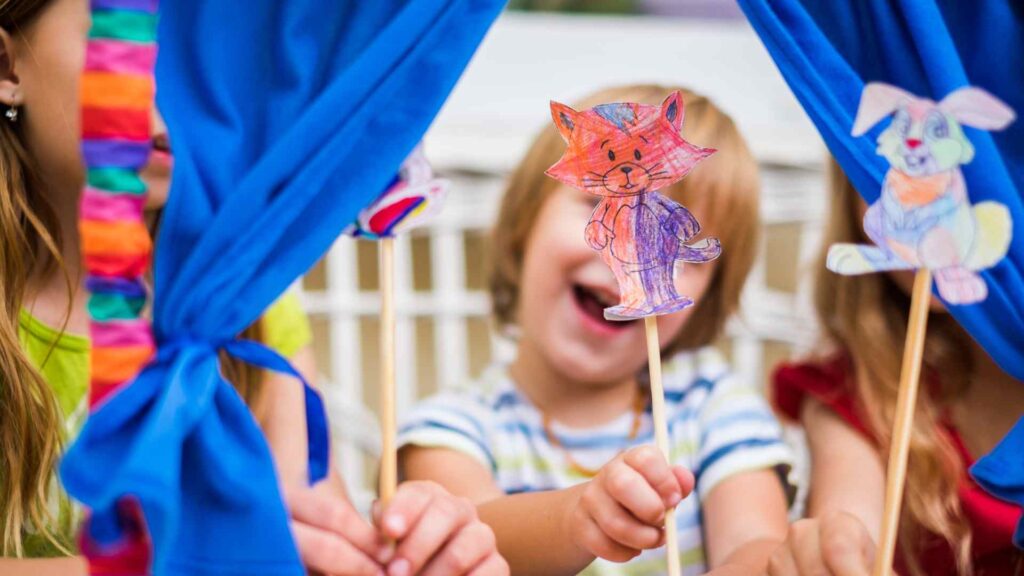
Exploring Shadow Puppets
Shadow puppets offer a unique and enchanting way to tell stories using light and silhouettes. Here’s how to create your own shadow puppets and stage magical performances:
What are Shadow Puppets?
Shadow puppets are flat figures or cutouts held between a light source and a screen or wall. They create shadows that depict characters and scenes, making them ideal for storytelling in a darkened room.
Materials and Tools for Shadow Puppets
- Materials Needed:
- Cardstock or black construction paper
- Scissors
- Craft sticks or wooden dowels
- Tape or glue
- Optional: Colored cellophane or tissue paper for adding color effects
- Light Source:
- Use a lamp or flashlight positioned behind the puppet to cast shadows onto a blank wall or screen.
Creating Shadow Puppet Characters
- Drawing and Cutting Silhouettes:
- Draw your puppet designs on cardstock or black paper and cut them out carefully. Keep the shapes simple and recognizable for effective shadow play.
- Consider characters like animals, people, or objects that fit the story you want to tell.
- Attaching Sticks or Rods:
- Tape or glue craft sticks or wooden dowels to the back of each puppet. Ensure they are securely attached for easy manipulation during performances.
Setting Up a Shadow Puppet Theater
- Creating a Backdrop:
- Hang a white sheet or use a large blank wall as your screen. Ensure it’s smooth and free from distractions to enhance the shadow effect.
- Positioning the Light Source:
- Place your lamp or flashlight behind the puppet theater, aiming towards the screen to create clear and sharp shadows of your puppets.
Shadow puppets offer endless possibilities for storytelling and creativity. Once you’ve crafted your puppets and set up your theater, experiment with different light angles and puppet movements to bring your stories to life in the most magical way possible.
Bringing Your Puppets to Life
Once you’ve crafted your puppets, it’s time to master the art of puppet manipulation and storytelling. Here’s how to make your characters come alive:
Basics of Puppet Manipulation
- Hand Puppets: Slide your hand inside the puppet and use your fingers to move its arms, head, and mouth. Practice different gestures and movements to convey emotions and actions.
- Finger Puppets: Place these puppets on your fingers and use simple movements to animate them. Each finger can represent a different character or interact with props in the puppet show.
- Shadow Puppets: Hold these puppets between a light source and a screen. Use precise movements to create silhouettes that depict characters and scenes.
Simple Puppetry Techniques
- Focus and Expression: Use eye contact and facial expressions to communicate emotions. Practice changing the puppet’s expression by tilting its head or moving its features.
- Voice and Dialogue: Develop distinct voices for your puppets to differentiate characters. Experiment with tone, pitch, and accents to bring personality to each puppet.
- Movement and Action: Plan choreographed movements for your puppets to act out scenes. Practice smooth transitions and coordinated actions for a polished performance.
Practicing Puppet Voices and Movements
- Role-Playing: Encourage children to role-play scenarios with their puppets. This helps them develop storytelling skills and explore different perspectives.
- Improvisation: Create improvised puppet shows where characters interact and respond to unexpected situations. This fosters creativity and quick thinking.
Mastering puppet manipulation takes practice, patience, and imagination. Encourage kids to experiment with their puppets, explore new stories, and enjoy the magic of bringing characters to life through puppetry.
Puppet Shows and Storytelling
Creating and performing puppet shows is a wonderful way to showcase your puppets’ personalities and engage audiences of all ages. Here’s how to craft compelling stories and stage captivating performances:
Creating a Puppet Show Script
- Developing Characters and Plots: Brainstorm with your kids to create characters with distinct personalities and motivations. Outline a storyline with a beginning, middle, and end.
- Writing Dialogue: Craft dialogue that suits each character’s voice and advances the plot. Keep it simple and engaging for young audiences.
- Incorporating Themes: Explore themes like friendship, adventure, or problem-solving to teach valuable lessons through storytelling.
Setting Up a Puppet Theater at Home
- Choosing a Performance Space: Select a cozy area with enough space for puppets to move freely. Consider using a small table or constructing a makeshift stage with blankets or cardboard.
- Backdrop and Props: Create a backdrop using a large sheet or fabric to set the scene. Use props like miniature furniture or scenery to enhance storytelling.
- Lighting and Sound Effects: Experiment with different lighting effects to create ambiance. Use music or sound effects to enhance dramatic moments in your puppet show.
Tips for Performing a Puppet Show
- Engaging the Audience: Encourage interaction by inviting viewers to participate or respond to cues during the performance.
- Puppet Manipulation: Practice smooth transitions and synchronized movements between characters. Use gestures and facial expressions to convey emotions effectively.
- Rehearsals: Conduct rehearsals to fine-tune performances and build confidence in delivering lines and actions.
Encouraging Kids to Create Their Own Stories
- Imagination and Creativity: Inspire children to invent their own puppet characters and storylines. Foster a supportive environment where they can experiment with different ideas and storytelling techniques.
- Teamwork and Collaboration: Encourage siblings or friends to join in creating and performing puppet shows together. This promotes teamwork and shared creativity.
By encouraging puppet shows and storytelling, you not only foster creativity and communication skills but also create lasting memories with your children. Enjoy the magic of puppetry as you bring imaginative tales to life with your handmade puppets!
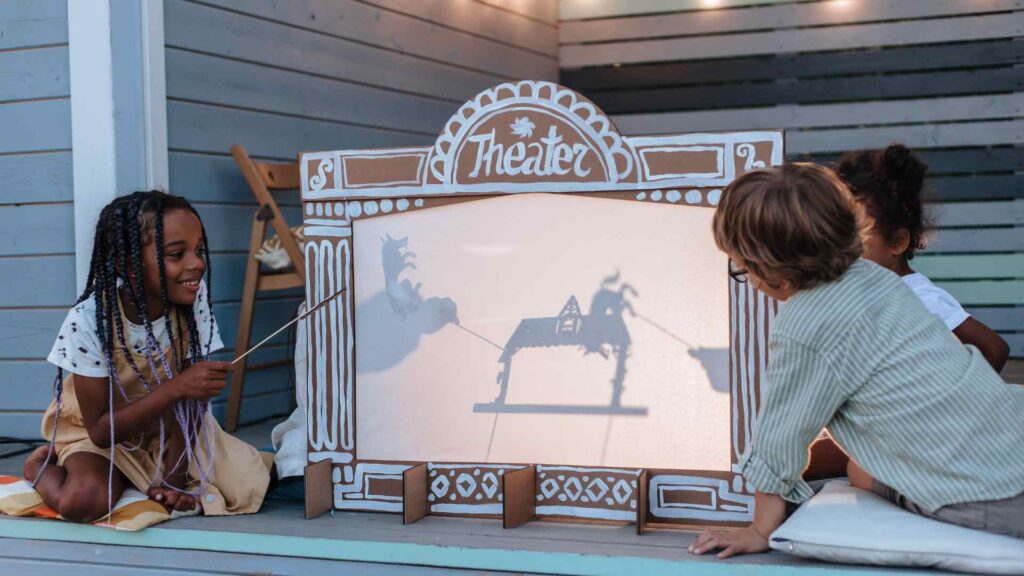
Beyond the Basics
Once you’ve mastered the fundamentals of puppet making and storytelling, explore advanced techniques to elevate your puppetry skills and creativity:
Advanced Puppet-Making Techniques
- Using Complex Materials: Experiment with materials like latex, foam, or articulated joints to create more intricate puppet designs.
- Adding Mechanisms for Movement: Integrate mechanisms such as strings or levers to control puppet movements like blinking eyes or waving arms.
- Designing Detailed Costumes: Craft elaborate costumes using sewing techniques and fine fabrics to enhance your puppet’s appearance.
Incorporating Technology: Digital Puppetry and Animatronics
- Digital Puppetry: Utilize computer software or apps that simulate puppet movements on-screen. Explore digital storytelling possibilities with animated characters.
- Animatronics: Combine puppetry with robotics to create puppets with automated movements and sound effects. This advanced technique adds realism and interactivity to puppet performances.
Puppet Maintenance and Care
- Cleaning and Storage: Regularly clean puppets to maintain their appearance and durability. Store them in a cool, dry place to prevent damage from dust or humidity.
- Repairing Wear and Tear: Address minor damages promptly, such as reattaching loose seams or replacing worn-out features like eyes or clothing.
- Preserving Memories: Document your puppet-making journey and performances through photos or videos. Create a puppet portfolio to showcase your projects and progress over time.
Continued Learning and Exploration
- Workshops and Classes: Attend puppetry workshops or classes to learn new techniques and connect with other puppet enthusiasts.
- Community Engagement: Participate in local puppetry festivals or events to share your creations and inspire others with your puppetry skills.
- Personal Growth: Challenge yourself with ambitious puppet projects that push your creative boundaries and expand your puppet-making expertise.
By exploring advanced puppet-making techniques and embracing technology, you can take your puppetry hobby to new heights.
Whether you’re crafting intricate puppets or experimenting with digital storytelling, the possibilities for creativity and innovation are endless. Enjoy the journey of continuous learning and discovery in the art of puppetry!
Fun Puppet Projects for Different Age Groups
Puppetry offers engaging activities suitable for various age ranges, fostering creativity and learning through hands-on projects.
Here are tailored puppet projects for different stages of childhood development:
Puppets for Toddlers and Preschoolers
- Simple Finger Puppets: Create colorful animal or character finger puppets using felt or paper. Focus on large, easy-to-manipulate designs that encourage imaginative play.
- Storybook Character Puppets: Make puppets based on favorite storybook characters. Use simple shapes and bright colors to capture toddlers’ attention and encourage storytelling.
Projects for School-Age Kids
- Hand Puppets with Emotion: Craft hand puppets with movable features like mouths and eyes. Encourage children to explore emotions by creating puppets that express different feelings.
- Themed Puppet Shows: Collaborate on creating themed puppet shows based on historical events, science topics, or fairy tales. Develop scripts and practice puppet manipulation techniques for a performance.
Advanced Projects for Teens
- Shadow Puppetry Productions: Design intricate shadow puppets depicting complex scenes or narratives. Experiment with lighting techniques and create dynamic performances using multiple puppets.
- Digital Puppetry and Animation: Explore digital tools to design and animate puppets on-screen. Combine storytelling with technology to create interactive puppet shows or short films.
Encouraging Creativity and Collaboration
- Group Projects: Organize puppet-making workshops or group activities where children can collaborate on designing and performing puppet shows. Foster teamwork and creative problem-solving skills.
- Independent Exploration: Encourage teens to pursue personal puppetry projects based on their interests and skills. Provide resources and guidance as they experiment with advanced techniques and storytelling approaches.
By tailoring puppet projects to each age group’s abilities and interests, you can inspire children and teens to explore their creativity, develop new skills, and share their imaginative stories through puppetry. Enjoy the journey of creating memorable puppet experiences together!
